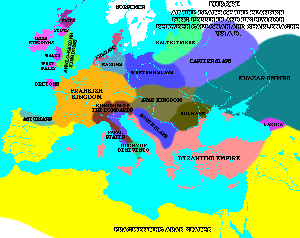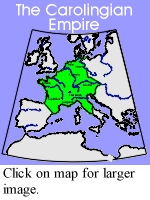End of Europe's Middle Ages

Map of Europe in 768 A.D. showing the Frankish Empire. Click on map for larger image. |
In the eighth century, the Frankish Empire underwent extensive consolidations during the reigns of Charles Martel, Pepin the Short, and Charlemagne. The end result was that the Frankish king had become the single most powerful lord in Europe at the time. This situation was recognised when, on Christmas Day 800, Charlemagne was crowned 'Emperor of the Romans' by Pope Leo III at Rome. When the Empire was divided between Charlemagne's grandsons in 840, the split was along linguistic lines - French to the west, German to the east, and a narrow strip down the centre that would be the cause of bitter territorial disputes between France and Germany into the twentieth century.
|
In the ninth and tenth centuries, Europe was disrupted by a series of invasions by Vikings, Hungarians, and Muslims. When the invasions finally subsided, Germany's initial recovery was characterised by the emergence of semi-independent duchies based on earlier Germanic tribal divisions. By the early tenth century, five duchies dominated Germany: Bavaria, Franconia, Lorraine, Saxony, and Swabia. After the death of the last Carolingian emperor in 911, the monarchy fell into the hands of the dukes of Franconia and Saxony until the Saxon line was able to assimilate the crown into their dynastic line. The dukes of Saxony soon extended their control over Franconia and Lorraine and retained the German monarchy for the next century. The second king in the Saxon line was Otto I, the Great, who consolidated his authority in Germany and added the title of 'King of Italy' in 951. His successful defence of Germany against the Hungarians in 955 validated his claim as monarch over the German princes and, in 962, Otto I was crowned 'Roman Emperor' by Pope John XII. Although the term 'Holy Roman Empire' would not be regularly used until the twelfth century, Otto I's coronation marked the beginning of the medieval Holy Roman Empire which was to remain a fundamentally German phenomenon until its demise in the nineteenth century. |
 |
Return to Holy Roman Empire |
The End of Europe's Middle Ages / Applied History Research Group / University of Calgary
Copyright © 1997, The Applied History Research Group
